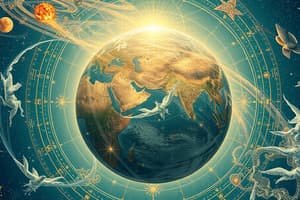Podcast
Questions and Answers
Which layer of the atmosphere contains most of the weather phenomena like clouds and rain?
Which layer of the atmosphere contains most of the weather phenomena like clouds and rain?
- Stratosphere
- Troposphere (correct)
- Thermosphere
- Mesosphere
Which of the following layers represents the outermost part of the Earth's atmosphere?
Which of the following layers represents the outermost part of the Earth's atmosphere?
- Thermosphere
- Mesosphere
- Exosphere (correct)
- Stratosphere
What does the geosphere encompass?
What does the geosphere encompass?
- Bodies of water such as oceans and lakes
- The Earth's land and interior (correct)
- The layers of the atmosphere
- All living organisms
What is the process in which continental landmasses shift position called?
What is the process in which continental landmasses shift position called?
Which statement best describes the composition of Earth's core?
Which statement best describes the composition of Earth's core?
How do oceanic and continental crusts primarily differ?
How do oceanic and continental crusts primarily differ?
At what rate do tectonic plates generally move?
At what rate do tectonic plates generally move?
Which component of the Earth is primarily in a liquid state?
Which component of the Earth is primarily in a liquid state?
Which theory explains the origin of the universe as resulting from an enormous explosion?
Which theory explains the origin of the universe as resulting from an enormous explosion?
What is the primary unique characteristic of Earth compared to other planets in the solar system?
What is the primary unique characteristic of Earth compared to other planets in the solar system?
What are the four subsystems of the Earth mentioned?
What are the four subsystems of the Earth mentioned?
What did the early Earth primarily consist of before it cooled down?
What did the early Earth primarily consist of before it cooled down?
The Endosymbiosis Theory suggests that eukaryotic cells originated from what?
The Endosymbiosis Theory suggests that eukaryotic cells originated from what?
In the Geologic Time Scale, which intervals are the largest?
In the Geologic Time Scale, which intervals are the largest?
What characterizes the boundaries of eras in the Geologic Time Scale?
What characterizes the boundaries of eras in the Geologic Time Scale?
Which process involves using sunlight to convert carbon dioxide and water to food and oxygen?
Which process involves using sunlight to convert carbon dioxide and water to food and oxygen?
Flashcards are hidden until you start studying
Study Notes
Origin of the Universe and Solar System
- Solar Nebula Theory posits the solar system originated from a spinning cloud of dust.
- Big Bang Theory suggests the universe began from an enormous explosion approximately 13.8 billion years ago.
Earth's Unique Characteristics
- Earth is the only planet in the solar system known to support and sustain life.
- Formed about 4.5 billion years ago, with its initial state being molten material.
Earth's Atmosphere
- Early atmosphere lacked oxygen, composed of carbon dioxide, steam, ammonia, and methane from volcanic eruptions.
- Photosynthesis by early organisms converted carbon dioxide and water into food energy and oxygen.
Endosymbiosis Theory
- Proposed by Lynn Margulis, suggesting eukaryotic cells evolved from primitive prokaryotic cells merging with plant and animal cells in symbiosis.
Geologic Time Scale
- A framework for understanding Earth history, divided into eons, eras, periods, and epochs.
- Eons are the largest intervals, lasting hundreds of millions of years.
- Eras mark significant events in Earth's history and are subdivided into periods.
- Periods are further divided into epochs, corresponding to chronostratigraphic series.
Earth Subsystems
- Four main subsystems: Atmosphere, Geosphere, Hydrosphere, and Biosphere.
Atmosphere
- Comprises several layers:
- Troposphere: Contains most weather events.
- Stratosphere: Houses the ozone layer.
- Mesosphere: Meteors burn up here.
- Thermosphere: High-energy radiation absorption.
- Exosphere: Outermost layer, the boundary of Earth’s gaseous envelop.
Geosphere
- The largest sphere, extending from the Earth’s surface to its core, composed of solid rocky layers.
Hydrosphere
- Encompasses all water on Earth including streams, lakes, glaciers, and underground water.
Biosphere
- Represents all living organisms on Earth.
Continental Drift
- Theory proposed by Alfred Wegener in 1912, explaining the movement of continental landmasses.
- Noted the coastline similarities between western Africa and eastern South America.
- Pangaea was the single supercontinent from which modern continents have drifted.
Evidence Supporting Continental Drift
- Apparent fit of continents.
- Correlation of rock formations and mountain ranges across continents.
- Paleoclimate data revealing historical climate conditions.
Plate Tectonics
- Earth's crust is divided into plates moving at speeds of 1 to 10 cm per year.
- Most seismic activity occurs at plate boundaries, impacting both oceanic and continental crust.
Earth's Internal Structure
- Crust: Thin outermost layer composed of two types—continental and oceanic.
- Mantle: Middle layer, extending nearly 2,900 km, comprises both a solid lithosphere and a semi-fluid asthenosphere.
- Core: Center of the Earth composed of an iron-nickel alloy; outer core is in liquid form while the inner core is solid.
Studying That Suits You
Use AI to generate personalized quizzes and flashcards to suit your learning preferences.




